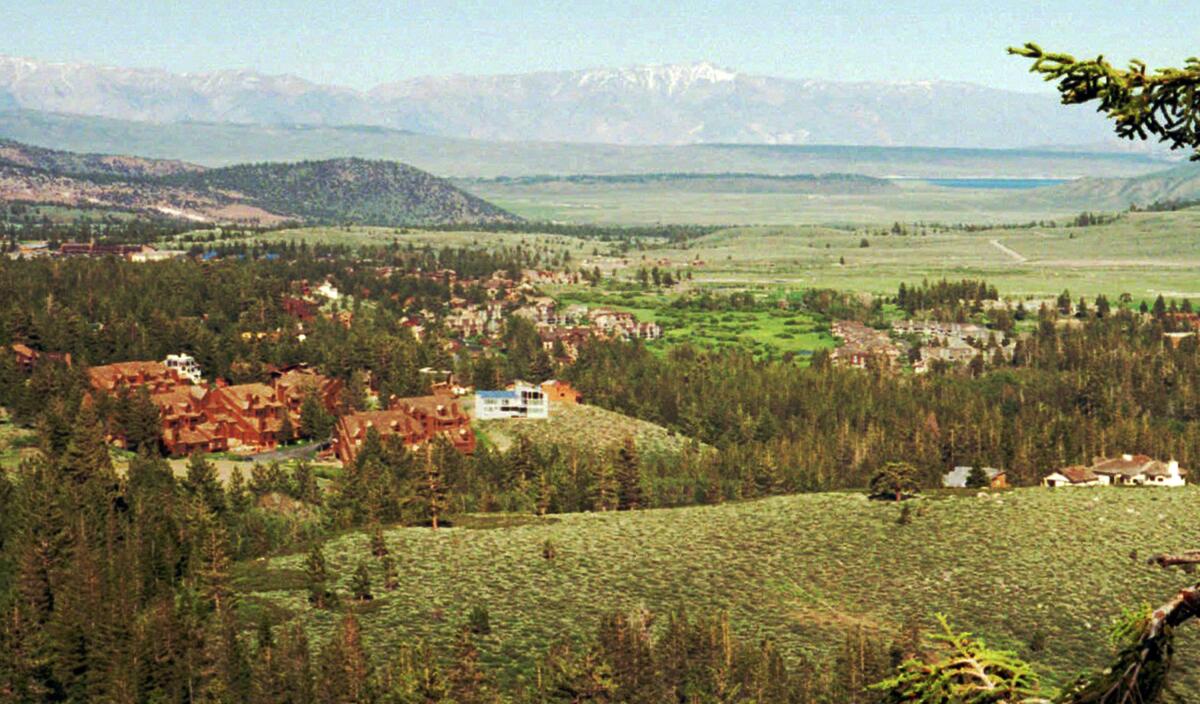Op-Ed: A volcano near Mammoth Lakes didn’t erupt in 1982 — but the town did

- Share via
In the run-up to Memorial Day weekend in 1982, Mammoth Lakes residents woke up to a Los Angeles Times headline that said: “Mammoth Area Tremors Hint at Volcanism.” The report rocked the region, but not in the way residents were warned to expect.
A series of small earthquakes near Mammoth Lakes in the Eastern Sierra had raised “the possibility of some sort of volcanic activity there,” the article began. U.S. Geological Survey scientists were planning to put the area on volcanic “notice” or “watch” status due to earthquake swarms and other monitoring data.
The agency had identified a possible eruption site about two miles from Mammoth Lakes at the edge of what is called the Long Valley, but it is really a collapsed volcanic crater that was formed about 760,000 years ago by a violent eruption. Subsequent publications sensationalized the potential early 1980s volcanic activity, one inaccurately describing “brewing lava eruptions.”
Blind-sided residents were outraged, especially after weeks and months came and went, and nothing happened. The United States Geological Survey scientists found threatening messages in their cars. Their agency was ridiculed locally as the United States Guessing Survey.
A pioneer of the California ski industry and avid adventurer, Dave McCoy built Mammoth Mountain over the course of six decades.
Scientists tried to mend fences. They said they wanted to teach the public how to live with an active volcano. It had only been two years since Mt. St. Helens had exploded; it remains the deadliest volcanic eruption in U.S. history and killed 57 people. And it had been preceded by earthquake swarms.
The USGS emphasized that it had issued the lowest-level volcano warning alert. It wasn’t a pronouncement of imminent doom, only a signal to enhance monitoring efforts and make common-sense preparations such as putting together an emergency supply kit and having an evacuation plan.
But the damage was done. A volcano didn’t blow. The Times article had set off what the newspaper later called “a summer of discontent.”
Tourism plummeted. Dozens of businesses reportedly closed. Real estate agents claimed sales were off by as much as 50% because of the media-created “volcano scare.” About 40% of Mammoth Lakes residents — more than 2,000 people — were said to have left town over the next two years.
Some local critics suggested the greatest threat to the community was not a volcanic eruption but, rather, media distortion of the volcano story.
David P. Hill, then the scientist in charge of USGS monitoring in the Mammoth region, was viewed as the enemy. “A real estate agent told me I should watch what I’m saying because somebody would put a bomb in my car,” Hill told me years later.
Restaurants and hotels in Mammoth Lakes posted signs that read: Geologists not welcome.
In 1997, Hollywood referenced the Mammoth/Long Valley saga by name in the disaster thriller “Dante’s Peak,” about a small mountain village in the northwest in denial as a dormant volcano begins to rev up. Pierce Brosnan starred as a USGS volcanologist, briefly glamorizing the profession of geologic researcher. That didn’t exactly help things.
Movies: The pros get a look at the thriller and are mostly impressed. But about that acid lake. . . .
After the 1982 fiasco, Hill took it as his mission to repair the fractious relationship between the town and the scientists trying to safeguard it. He made endless trips between his office in Menlo Park and Mammoth Lakes, hoping to seed, then nurture a trust between those who live next to the volcano and those who watch it. The relationship did stabilize. But not overnight.
In 1998 when I first met Hill, who had a doctorate in geophysics, he was schlepping stacks of a four-page pamphlet titled “Living With a Restless Volcano” and distributing them to schools and Mono County officials. His career with the USGS would span more than 58 years before Hill died in 2018.
John Ewert, a scientist who headed the Cascades Volcano Observatory, once told me the education campaign Hill dedicated himself to at Long Valley changed the way the scientists were viewed. The agency’s added transparency included a regularly updated webpage where anyone could check activity alert statuses.
In 2019, Ewert helped lead a course at Mammoth Lakes aimed at educating regional wilderness officials, first responders such as firefighters and police officers, and government and health officials, among others. The Volcano Crisis Awareness meeting was held in the fire house, a symbolic milestone that volcano scientists would not have imagined a couple decades earlier.
The Mammoth Lakes/Long Valley volcano remains active but in the “non-eruptive background state.” The current activity level, the USGS says, is “normal,” the lowest possible alert.
In 2009, a 6.3-magnitude earthquake rocked central Italy, leading to the deaths of more than 300 people. Six scientists and a government official were charged with manslaughter; prosecutors maintained the scientists had failed to adequately warn the public in the wake of smaller tremors that preceded the earthquake. They were found guilty and sentenced to six years in prison, but the verdict was overturned on appeal.
Ewert and many other scientists who attempt to forecast natural disaster phenomena were chilled by the development.
“How do you maintain credibility over time with a system that’s evolving?” asked Ewert, echoing the challenge for scientists communicating the threat posed by earthquakes, volcanoes and, more recently, pandemics. “That’s a hard one.”
Todd Balf is the author of several books, including the memoir “Complications.”
More to Read
A cure for the common opinion
Get thought-provoking perspectives with our weekly newsletter.
You may occasionally receive promotional content from the Los Angeles Times.










